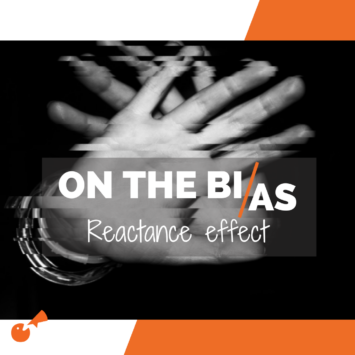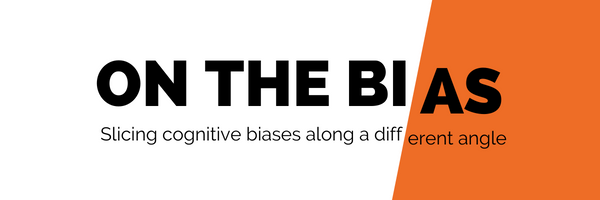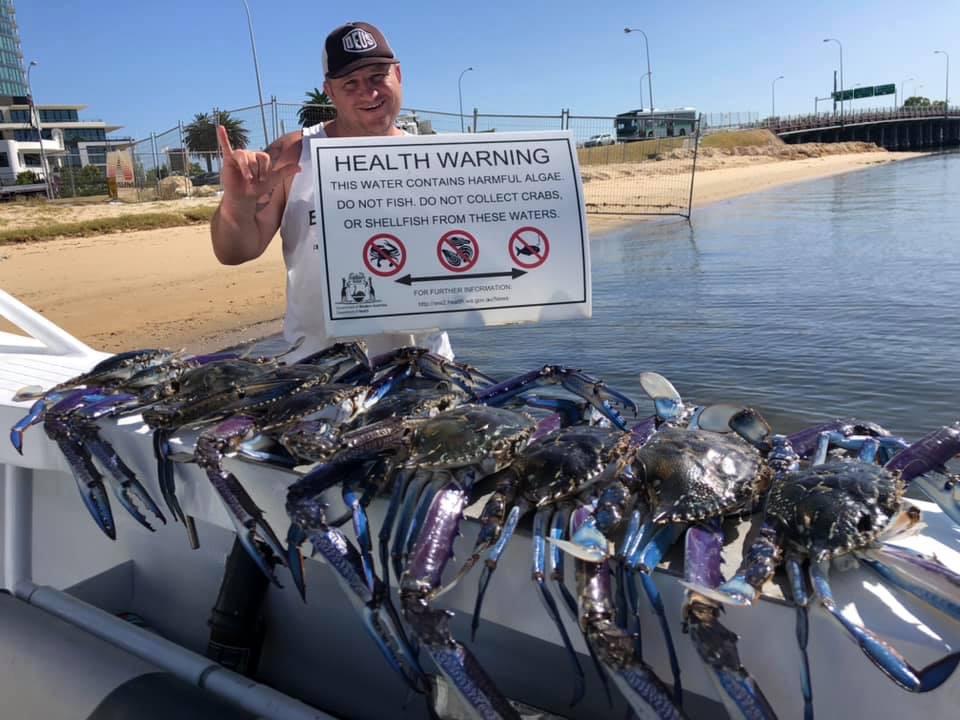
ON THE BIAS: Reactance Effect
Welcome back to the blog series, ON THE BIAS.
In this series, we look at the cognitive biases we have as humans and how they impact our behavior change efforts. Catch up with the previous posts here.

A story: I don’t wanna!!!
A handful of years ago, my Gastroenterologist (otherwise known as “my GI guy”) recommended I add more fiber to my diet.
He didn’t mean it in the fun way of eating awesome foods like oats, avocados, and raspberries. Chocolate-flavored fiber chews weren’t going to do the trick, either. Nope. My doctor wanted me to add a powder-based fiber supplement to my nightly routine.
I was not stoked to receive this guidance as someone who, at that time, had recently turned 40. Was I already turning into my father???
The powder-based fiber supplement is innocuous. It is tasteless, it completely dissolves in a small glass of water, and it is the easiest thing a doctor could “prescribe” me to do.
And yet, I resisted.
During the first three months of starting this habit, my spouse would ask me every night if I took my fiber (he’s an annoyingly helpful accountability buddy). In response, I would channel my inner petulant child, ball my fists, close my eyes, and proclaim, “I don’t wanna!” to the ceiling.
I would then mix and drink my fiber-infused water with a mad pout on my face.
What’s happening here?
These initial tantrums were the result of the reactance effect.
I was annoyed that I was being told to change my habits. I felt resentful that another “burden” was added to my bedtime routine. I was even upset at the reality that I needed a supplement at my age (reactance is often connected to cognitive dissonance).
My instinctive response to these emotions was to push back and resist.
ON THE BIAS: We are susceptible to responding negatively to rules, regulations, and advice that limit our options, restrict decision-making autonomy, and threaten our free behaviors. (Steindl et al., 2015).
Informally, we hate being told what to do.
Thankfully, my nightly tantrums have since dissipated (mostly). The drink is now part of my routine, and I have reaped the benefits of consuming more fiber.
But there are examples of the reactance effect happening all around us.
We witnessed multiple rounds of pushback around COVID-19 mask and vaccine mandates.
There was backlash and confusion earlier this year over the potential ban on gas stoves.
The other week, there was consumer outcry over Delta Airlines’ decision to change how frequent flier miles are earned.
And there is this guy…

Regardless of whether we feel these responses are right or wrong, they represent a human truth that we don’t often respond well to being told what to do.
Bringing the bias home: Take a minute to identify something you recently bristled at. It could be unsolicited advice given by a friend or family member, a seemingly nonsensical rule at a venue, or an annoying task your manager added to your plate.
It will likely be a moment where your inner voice said “I don’t wanna!” or “Screw them!” or “Make me!”
If you share a home with a toddler, tween, or teenager, you likely see the reactance effect on a daily basis. We’re sending you hugs of support!
How this bias can help or hurt our behavior change programs
HOW IT CAN HURT
This bias presents several challenges to our behavior change programs since we often tell or recommend audiences to do something differently, which will likely elicit a “why should I?” reaction at least.
Tobias Reynolds-Tylus accurately describes the challenge in this paragraph from his paper about psychological reactance with health communication efforts, which is similar to our challenges in sustainability and conservation.
“On one hand, messages with the objective of behavioral change or reinforcement must by necessity be clear in advocating for a specific recommended action. Though explicit persuasive messages are more likely to be understood by message recipients, they are also more likely to incite reactance due to being inherently freedom threatening in nature.
Thus, a pervasive challenge for health campaigns is balancing the need to be direct in advocating for desired behaviors while simultaneously avoiding language that may, either explicitly or implicitly, threaten an audience member’s freedom to choose their course of action.”
» Tobias Reynolds-Tylus, James Madison University
Yikes! That’s a challenge and a half!
Thankfully, there are messaging shifts and approaches we can incorporate to prevent adverse reactions and pushback.
DECREASE the use of forceful, controlling language such as: don’t, can’t, you must, stop, should, need to, etc. This type of language can feel proscriptive and restricting to audiences, which leads to backlash.
INCREASE the use of choice-enhancing, personally meaningful, and inviting language. We can engage the audience in the effort so it doesn’t feel like a top-down, authoritative approach.
- Shift the call to action away from things they should not do toward actions the audience can or could take.
- Provide choice in how the audience achieves the desired goal to increase their sense of autonomy. For example, suggesting that you can wear protective clothing or apply sunscreen regularly instead of telling people they must use sunscreen provides more choice. (Reynolds-Tylus, 2019. Pg. 6).
- Make the desired behavior more personally meaningful and relevant to the audience so they don’t feel the request is unreasonable.
GIVE ADVANCED NOTICE if significant changes are coming. Most backlash happens when the audience isn’t warned that something will change, and they feel blindsided (i.e., stripped of autonomy, voice, and choice). The Delta story above is a perfect example of this.
HOW IT HELPS
There is an aspect of the reactance effect that can activate determination instead of pushback.
Think of the times you’ve been unfairly told you can’t do something. Did it make you perk up and say, “I’ll show you!” Or, maybe it made you want to fight the system that is restricting your rights.
The Truth Campaign took this approach when it exposed the manipulative practices of big tobacco companies to mobilize young people to distrust the companies and reject cigarettes. We’ve seen some similar techniques in the climate activism movement.
This approach is most appropriate for organizations with a core mission of activism and disruption, like the Truth Initiative, which has strategies for channeling audience angst into action.
It should not be adopted lightly.
A NOTE OF CAUTION
Providing your audience with autonomy and choice helps prevent the reactance effect.
But this tactic can swing too far in the opposite direction if you give your audience too many options, causing choice overload, which makes it more difficult for audience members to take action.
For the best balance, aim for 2 to 3 options or “pathways” the audience can take to achieve the desired outcome.
I hope you enjoyed learning about one of the many ways we’re wired.
Want to travel down the rabbit hole of reactance? Check out these three papers on the topic:
- Reynolds-Tylus T (2019) Psychological Reactance and Persuasive Health Communication: A Review of the Literature. Front. Commun. 4:56. doi: 10.3389/fcomm.2019.00056. (PDF version available here).
- Staunton, Thomas V., Alvaro, Eusebio M., & Rosenberg, Benjamin D. (2020). A case for directives: Strategies for enhancing clarity while mitigating reactance. Current Psychology (2022) 41:611–621. https://doi.org/10.1007/s12144-019-00588-0 (PDF version available here).
- Steindl, C., Jonas, E., Sittenthaler, S., Traut-Mattausch, E., & Greenberg, J. (2015). Understanding Psychological Reactance: New Developments and Findings. Zeitschrift fur Psychologie, 223(4), 205–214. https://doi.org/10.1027/2151-2604/a000222. (PDF version available here).


